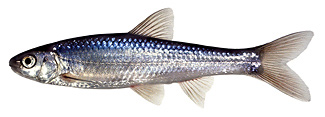Eastern Silvery Minnow
Hybognathus regius
 Distribution: Occurs along the Atlantic slope drainages from The St. Lawrence River in Quebec south to Georgia. In New Hampshire, the eastern silvery minnow has only been recorded in the Connecticut River.
Distribution: Occurs along the Atlantic slope drainages from The St. Lawrence River in Quebec south to Georgia. In New Hampshire, the eastern silvery minnow has only been recorded in the Connecticut River.
Description: The eastern silvery minnow can be difficult to identify due to its lack of distinguishing features. It has a small, subterminal mouth, a complete lateral line containing from 38 to 40 scales, a long, coiled intestine, and black peritoneum, which is sometimes visible through the abdominal wall. The eastern silvery minnow looks very similar to the spottail shiner, but it lacks the cross stitching or laced appearance along the lateral line of the spottail shiner and it does not have a spot at the base of the tail.
Species commonly confused with: Fallfish, common shiner, spottail shiner, golden shiner
Habitat: The eastern silvery minnow is found in large, slow moving rivers with gravel, sand, and silt substrates. It spawns in vegetated backwater coves and oxbows.
Life History: In early spring, the eastern silvery minnow congregates in large numbers to spawn in the backwaters and coves along the Connecticut River. Eggs are deposited on the silt bottom, where thick vegetation grows later in the season. Spawning takes place during day light and the young hatch after 6 or 7 days. A relatively short-lived species, the eastern silvery minnow spawns in its second year and rarely lives past age 3. Its diet consists mostly of benthic organic matter, which it is able to digest due to its relatively long intestine. Eastern silvery minnows are likely an important source of prey for predatory species like pike, walleye, and bass.
Origin: Native
Conservation/Management: Eastern silvery minnows may be an important indicator of healthy vegetated cove habitat along the Connecticut River. This habitat serves as spawning and nursery habitat for a number of fish species in the river. Water level fluctuations upstream and downstream of the mainstem dams throughout the Connecticut River mainstem may dewater these coves during critical spawning periods.



